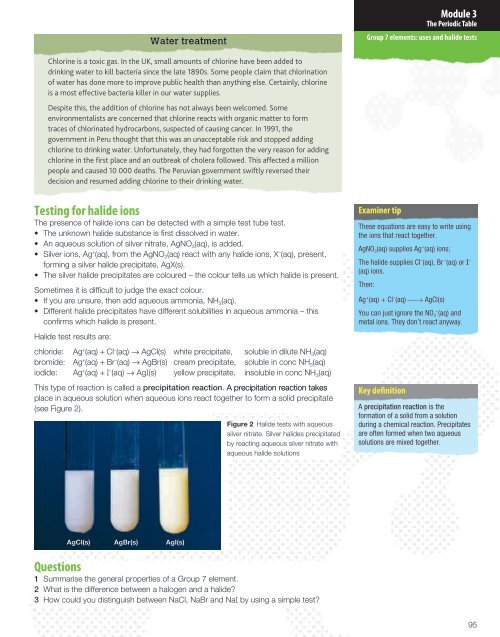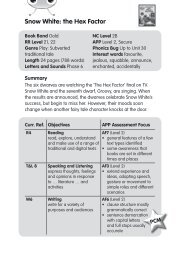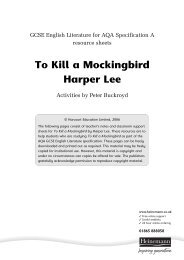Unit 1 Module 3 The Periodic Table - Pearson Schools
Unit 1 Module 3 The Periodic Table - Pearson Schools
Unit 1 Module 3 The Periodic Table - Pearson Schools
You also want an ePaper? Increase the reach of your titles
YUMPU automatically turns print PDFs into web optimized ePapers that Google loves.
Water treatment<br />
<strong>Module</strong> 3<br />
<strong>The</strong> <strong>Periodic</strong> <strong>Table</strong><br />
Group 7 elements: uses and halide tests<br />
Chlorine is a toxic gas. In the UK, small amounts of chlorine have been added to<br />
drinking water to kill bacteria since the late 1890s. Some people claim that chlorination<br />
of water has done more to improve public health than anything else. Certainly, chlorine<br />
is a most effective bacteria killer in our water supplies.<br />
Despite this, the addition of chlorine has not always been welcomed. Some<br />
environmentalists are concerned that chlorine reacts with organic matter to form<br />
traces of chlorinated hydrocarbons, suspected of causing cancer. In 1991, the<br />
government in Peru thought that this was an unacceptable risk and stopped adding<br />
chlorine to drinking water. Unfortunately, they had forgotten the very reason for adding<br />
chlorine in the first place and an outbreak of cholera followed. This affected a million<br />
people and caused 10 000 deaths. <strong>The</strong> Peruvian government swiftly reversed their<br />
decision and resumed adding chlorine to their drinking water.<br />
Testing for halide ions<br />
<strong>The</strong> presence of halide ions can be detected with a simple test tube test.<br />
• <strong>The</strong> unknown halide substance is first dissolved in water.<br />
• An aqueous solution of silver nitrate, AgNO 3 (aq), is added.<br />
• Silver ions, Ag + (aq), from the AgNO 3 (aq) react with any halide ions, X – (aq), present,<br />
forming a silver halide precipitate, AgX(s).<br />
• <strong>The</strong> silver halide precipitates are coloured – the colour tells us which halide is present.<br />
Sometimes it is difficult to judge the exact colour.<br />
• If you are unsure, then add aqueous ammonia, NH 3 (aq).<br />
• Different halide precipitates have different solubilities in aqueous ammonia – this<br />
confirms which halide is present.<br />
Halide test results are:<br />
chloride: Ag + (aq) + Cl – (aq) → AgCl(s) white precipitate, soluble in dilute NH 3 (aq)<br />
bromide: Ag + (aq) + Br – (aq) → AgBr(s) cream precipitate, soluble in conc NH 3 (aq)<br />
iodide: Ag + (aq) + I – (aq) → AgI(s) yellow precipitate, insoluble in conc NH 3 (aq)<br />
This type of reaction is called a precipitation reaction. A precipitation reaction takes<br />
place in aqueous solution when aqueous ions react together to form a solid precipitate<br />
(see Figure 2).<br />
Figure 2 Halide tests with aqueous<br />
silver nitrate. Silver halides precipitated<br />
by reacting aqueous silver nitrate with<br />
aqueous halide solutions<br />
Examiner tip<br />
T <br />
.<br />
AgNO 3 (aq) pp Ag + (aq) ;<br />
T pp Cl – (aq), Br – (aq) or I –<br />
(aq) .<br />
<strong>The</strong>n:<br />
Ag + (aq) + Cl – (aq) ⎯→ AgCl()<br />
Y j O 3– (aq) and<br />
. T .<br />
Key definition<br />
A precipitation reaction <br />
<br />
. p<br />
<br />
x .<br />
AgCl(s) AgBr(s) AgI(s)<br />
Questions<br />
1 Summarise the general properties of a Group 7 element.<br />
2 What is the difference between a halogen and a halide?<br />
3 How could you distinguish between NaCl, NaBr and NaI by using a simple test?<br />
95<br />
935 chemistry.U1 M3.indd 95 13/11/07 11:51:12 am
















